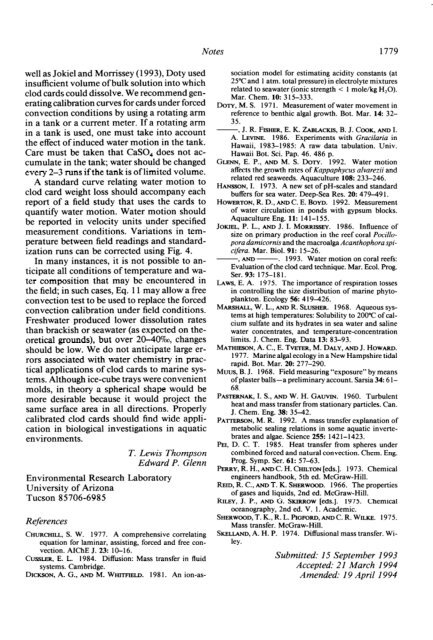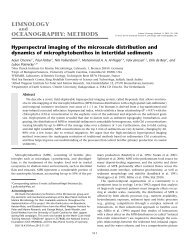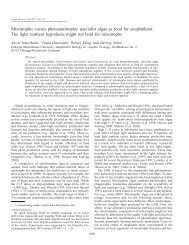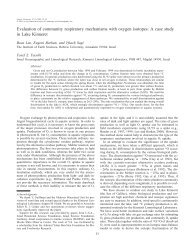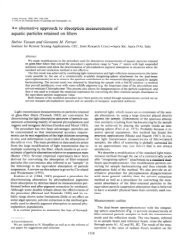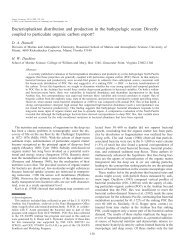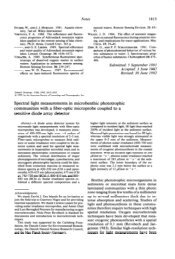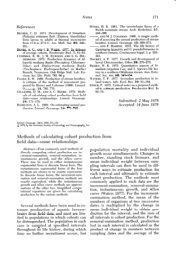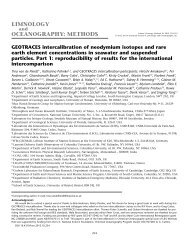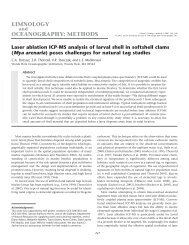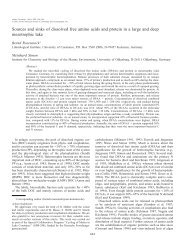Download - ASLO
Download - ASLO
Download - ASLO
Create successful ePaper yourself
Turn your PDF publications into a flip-book with our unique Google optimized e-Paper software.
Notes 1779<br />
well as Jokiel and Morrissey (1993), Doty used<br />
insufficient volume of bulk solution into which<br />
clod cards could dissolve. We recommend generating<br />
calibration curves for cards under forced<br />
convection conditions by using a rotating arm<br />
in a tank or a current meter. If a rotating arm<br />
in a tank is used, one must take into account<br />
the effect of induced water motion in the tank.<br />
Care must be taken that CaSO, does not accumulate<br />
in the tank; water should be changed<br />
every 2-3 runs if the tank is of limited volume.<br />
A standard curve relating water motion to<br />
clod card weight loss should accompany each<br />
report of a field study that uses the cards to<br />
quantify water motion. Water motion should<br />
be reported in velocity units under specified<br />
measurement conditions. Variations in temperature<br />
between field readings and standardization<br />
runs can be corrected using Fig. 4.<br />
In many instances, it is not possible to anticipate<br />
all conditions of temperature and water<br />
composition that may be encountered in<br />
the field; in such cases, Eq. 11 may allow a free<br />
convection test to be used to replace the forced<br />
convection calibration under field conditions.<br />
Freshwater produced lower dissolution rates<br />
than brackish or seawater (as expected on theoretical<br />
grounds), but over 20-40%, changes<br />
should be low. We do not anticipate large errors<br />
associated with water chemistry in practical<br />
applications of clod cards to marine systems.<br />
Although ice-cube trays were convenient<br />
molds, in theory a spherical shape would be<br />
more desirable because it would project the<br />
same surface area in all directions. Properly<br />
calibrated clod cards should find wide application<br />
in biological investigations in aquatic<br />
environments.<br />
Environmental Research Laboratory<br />
University of Arizona<br />
Tucson 85706-6985<br />
References<br />
T. Lewis Thompson<br />
Edward P. Glenn<br />
CHURCHILL, S. W. 1977. A comprehensive correlating<br />
equation for laminar, assisting, forced and free convection.<br />
AIChE J. 23: 10-l 6.<br />
CUSSLER, E. L. 1984. Diffusion: Mass transfer in fluid<br />
systems. Cambridge.<br />
DICKSON, A. G., AND M. WHITFIELD. 1981. An ion-as-<br />
sociation model for estimating acidity constants (at<br />
25°C and 1 atm. total pressure) in electrolyte mixtures<br />
related to seawater (ionic strength < 1 mole/kg H,O).<br />
Mar. Chem. 10: 315-333.<br />
Dorv, M. S. 1971. Measurement of water movement in<br />
reference to benthic algal growth. Bot. Mar. 14: 32-<br />
35.<br />
-, J. R. FISHER, E. K. ZABLACKIS, B. J. COOK, AND I.<br />
A. LEVINE. 1986. Experiments with Gracilaria in<br />
Hawaii, 1983-1985: A raw data tabulation. Univ.<br />
Hawaii Bot. Sci. Pap. 46. 486 p.<br />
GLENN, E. P., AND M. S. DO-I-Y. 1992. Water motion<br />
affects the growth rates of Kappaphycus alvarezii and<br />
related red seaweeds. Aquaculture 108: 233-246.<br />
HANSSON, I. 1973. A new set of pH-scales and standard<br />
buffers for sea water. Deep-Sea Res. 20: 479-491.<br />
HOWERTON, R. D., AND C. E. BOYD. 1992. Measurement<br />
of water circulation in ponds with gypsum blocks.<br />
Aquaculture Eng. 11: 141-155.<br />
JOIUEL, P. L., AND J. I. MORRISSEY. 1986. Influence of<br />
size on primary production in the reef coral Pocillopora<br />
damicornis and the macroalga Acanthophora spiczjka.<br />
Mar. Biol. 91: 15-26.<br />
-, AND -. 1993. Water motion on coral reefs:<br />
Evaluation of the clod card technique. Mar. Ecol. Prog.<br />
Ser. 93: 175-181.<br />
LAWS, E. A. 1975. The importance of respiration losses<br />
in controlling the size distribution of marine phytoplankton.<br />
Ecology 56: 419-426.<br />
MARSHALL, W. L., AND R. SLUSHER. 1968. Aqueous systems<br />
at high temperatures: Solubility to 200°C of calcium<br />
sulfate and its hydrates in sea water and saline<br />
water concentrates, and temperature-concentration<br />
limits. J. Chem. Eng. Data 13: 83-93.<br />
MATHIESON, A. C., E. T-R, M. DALY, AND J. HOWARD.<br />
1977. Marine algal ecology in a New Hampshire tidal<br />
rapid. Bot. Mar. 20: 277-290.<br />
Mws, B. J. 1968. Field measuring “exposure” by means<br />
of plaster balls-a preliminary account. Sarsia 34: 6 l-<br />
68.<br />
PASTERNAK, I. S., AND W. H. GAUVIN. 1960. Turbulent<br />
heat and mass transfer from stationary particles. Can.<br />
J. Chem. Eng. 38: 3542.<br />
PA-N, M. R. 1992. A mass transfer explanation of<br />
metabolic sealing relations in some aquatic invertebrates<br />
and algae. Science 255: 1421-1423.<br />
PEI, D. C. T. 1985. Heat transfer from spheres under<br />
combined forced and natural convection. Chem. Eng.<br />
Prog. Symp. Ser. 61: 57-63.<br />
PERRY, R. H., AND C. H. CHILTON [eds.]. 1973. Chemical<br />
engineers handbook, 5th ed. McGraw-Hill.<br />
REID, R. C., AND T. K. SHERWOOD. 1966. The properties<br />
of gases and liquids, 2nd ed. McGraw-Hill.<br />
RILEY, J. P., AND G. SKIRROW [eds.]. 1975. Chemical<br />
oceanography, 2nd ed. V. 1. Academic.<br />
SHERWOOD, T. K., R. L. PIGFORD, AND C. R. WILKE. 1975.<br />
Mass transfer. McGraw-Hill.<br />
SKELLAND, A. H. P. 1974. Diffusional mass transfer. Wiley.<br />
Submitted: 1.5 September 1993<br />
Accepted: 21 March 1994<br />
Amended: 19 April 1994


